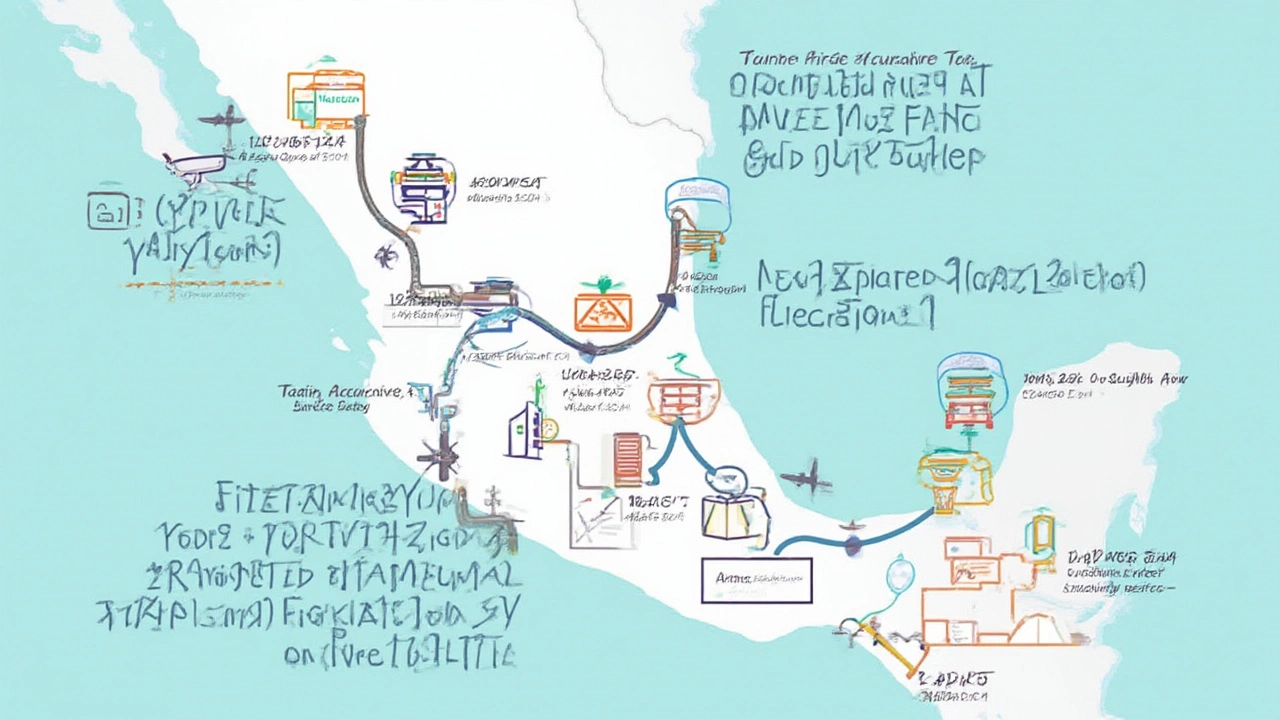If you Google “is medical tourism safe in Mexico?”, you’ll see everything from glowing patient reviews to scary stories of surgeries gone wrong. It’s not just internet hype. Mexico pulls in almost 1.2 million foreign medical travelers every year, making it the world’s second biggest destination for medical tourism. What isn’t talked about as much? The real risks, the real benefits, and the choices that can mean the difference between a successful surgery and a disaster you’ll wish you could undo.
Why Mexico Became a Giant in Medical Tourism
Let’s start with why so many people are willing to fly to Mexico for healthcare. The biggest pull? The prices. You can get a knee replacement in Tijuana for a chunk of what you’d pay in Tulsa. Dental implants, bariatric surgery, fertility treatment—the list goes on. Sometimes savings reach 70%, and that’s after you factor in travel, hotels, and a week recovering by the pool.
But it’s not just about the money. Wait times in countries like Canada, the US, or the UK can be a nightmare. In Mexico, you book, you fly down, you get the procedure, and you’re back home before the local hospital’s even sent you an appointment letter. Many Mexican clinics invest in the latest equipment and employ surgeons who trained in the States or Europe. In border cities like Tijuana or Monterrey, English is common and some hospitals look like luxury hotels—no joke, there are even personal concierges in some places.
Here’s where it gets interesting. Mexico’s private healthcare system is totally separate from its public one. Foreigners flock to the private side. Some hospitals—especially in top destinations—have International Patient departments that prep everything for you, right from airport pickup. According to a 2024 report from Patients Beyond Borders, 85% of medical tourists in Mexico rate their experience as “good” or “excellent.” They usually cite fast treatment, friendly staff, and cost savings. However, only about half of medical travelers research a clinic’s accreditations in depth. That statistic should set off an alarm bell.
The Real Risks You Need to Know Before Booking
Price tags this low do come with risks. Mexican medical care isn’t a lawless Wild West, but the standards can vary a lot from one place to the next. There’s excellent care, and there’s care you wouldn’t wish on your worst enemy. For starters, Mexico’s medical licensing system works, but enforcement isn’t always strict, especially in lesser-known clinics. While cities like Tijuana, Cancun, and Mexico City have big-name hospitals with JCI accreditation (think of this like the gold seal for safety and quality worldwide), hundreds of smaller clinics don’t. Many simply rely on their Google ratings or Instagram before-and-after shots to get patients.
The other real danger? Communication barriers. Not all doctors speak fluent English. Misunderstandings can occur. That’s a big deal if you need to explain allergies, previous surgeries, or your prescription history. Likewise, aftercare and follow-up can get complicated when your surgeon is two countries away. According to Mexican Association of Plastic, Aesthetic and Reconstructive Surgery, about 10% of foreign patients encounter some issue—from minor infections to major complications—when they pick clinics without international accreditation. Compare that with less than 3% at selected top-tier hospitals.
Corruption and counterfeit drugs are another problem—especially with pharmacies near the borders trying to cash in on foreign patients. The FDA and Mexico’s health authorities have both issued warnings in 2024 about fake Botox, antibiotics, and painkillers showing up. Don’t assume every medication is legit just because it’s sold in a “pharmacy.” Always make sure you get prescriptions written out and filled at reputable pharmacies (or straight from your clinic, if possible).
| Type of Procedure | Average Cost in US | Average Cost in Mexico | Possible Savings (%) |
|---|---|---|---|
| Dental Implant | $3,500 | $900 | 74% |
| Rhinoplasty | $7,500 | $3,000 | 60% |
| IVF Cycle | $12,000 | $4,200 | 65% |
| Gastric Sleeve | $16,000 | $4,800 | 70% |

How to Make Medical Tourism in Mexico Safer
So you’re still interested—and honestly, for many people, it really does go well. But you need a smart plan. Here’s what experienced travelers and doctors suggest if you want the safest shot at a successful trip:
- Never book from social media alone. Instagram and Facebook ads are loaded with glowing reviews and filtered photos, but these tell you almost nothing about real qualifications.
- Look for clinics with international accreditations. The Joint Commission International (JCI), the Canadian Accreditation Council, or the Mexican General Health Council are all respected. If your clinic is missing these, think twice.
- Insist on video consultations with your doctor before booking. Ask where they trained, about board certifications (especially if you want a complex surgery), and for references to English-speaking past patients.
- Get everything in writing. This covers your medical plan, the cost breakdown, and what is included (tests, medication, follow-up visits).
- Check for reviews in independent forums (like Reddit’s r/MedicalTourism or expat communities), not just on the clinic’s site. Watch for reviews that mention complications and how the clinic responded.
- Stay at least seven days after major surgery for post-op care. Don’t rush home—you need time for any problems to turn up while you’re still near your surgeon.
- If possible, bring a companion. They’ll notice details you miss and advocate for you if you feel out of it post-surgery.
- Arrange travel insurance that specifically covers medical tourism. Standard travel insurance usually won’t help if things go wrong with an elective procedure.
- Ask about emergency protocols. What happens if something goes wrong during surgery? Make sure the facility has an ICU and an agreement with a larger hospital if needed.
- Only use authorized pharmacies, and keep prescriptions and receipts for every drug you get.
Also, watch for red flags like upfront payment in full, rushed consultations, or doctors pushing extra “add-on” procedures. If something feels off, trust your gut.
Real Patient Experiences: Successes, Surprises, and Hard Lessons
Every year, you’ll find people flying home thrilled—whiter teeth, smaller waists, newfound confidence. The stories that get missed are often the closer calls. Take Sarah, a 38-year-old from Texas, who chose a clinic in Cancun for gastric sleeve surgery. She saved $10,000, but ended up needing a second, emergency surgery back home six weeks later due to a leak. She admits she skimmed over researching aftercare and never checked her surgeon’s accreditation. Then there’s Paul. He got a full dental restoration near Los Algodones. He paid just $2,100—less than a quarter of what he’d spend in Phoenix—and still raves about the care on Facebook three years later.
It’s a mixed bag. Some clinics have reputation management teams who bury bad reviews, so you only see the best. On the other hand, hospitals like Galenia in Cancun or Angeles in Tijuana have solid relationships with US hospitals, arrange video calls with specialists, and assign bilingual case managers from start to finish. These are the clinics that consistently score high with Canadian, European, and American patients.
Don’t discount the culture shock. Even if you’re used to traveling, adding surgery and pain meds to the mix is stressful. Language barriers flare up when you’re groggy and stressed. Many travelers say joining an expat forum or hiring a bilingual patient advocate made all the difference if something felt “off.” And yes, bring your medical records, just in case. This isn’t just a safety net—it saves time if you end up seeing a new doctor for any reason.

What the Stats and Experts Really Say About Safety
Let’s talk numbers. According to the 2024 Pan American Health Organization data, Mexico’s best private hospitals rival US standards when it comes to safety and patient outcomes. These hospitals have strict infection control, high nurse-to-patient ratios, and in-house diagnostic labs. But the bad clinics are a problem—and they’re out there. Mexican health authorities closed over 80 “ghost” clinics in 2023 alone for running with fake licenses or unlicensed staff. That’s the unvarnished truth: you can find world-class care and next-level nightmares, often in the same city.
Experts also point out that complications aren’t rare—especially when patients pick the cheapest option, skip in-depth checks, or ignore red flags. A 2023 study in the Journal of Travel Medicine put complication rates for Americans and Canadians receiving surgery in Mexico at roughly 8%. This included infections, poorly controlled pain, or the need for additional surgery. At top-tier, internationally accredited hospitals, that number drops to under 2.5%—comparable to the US or Canada. It’s not luck. It’s because these hospitals follow the same strict standards, run internal audits, and don’t cut corners.
| Hospital Type | % of International Patients | Complication Rate |
|---|---|---|
| JCI-Accredited Hospitals | ~60% | 2.5% |
| Non-Accredited Clinics | ~25% | 8% |
| Low-Cost "Pop-Up" Clinics | ~15% | 19% |
Big warning: American health insurance almost never covers elective procedures abroad. If things go wrong, fixing them back home gets pricey, and many US surgeons are reluctant to take on “medical tourism” revisions because of legal and insurance headaches.
The bottom line? Medical tourism in Mexico isn’t a guaranteed disaster—but it’s not a guaranteed success, either. Doing your research, checking accreditation, organizing real aftercare, and planning for emergencies makes a major difference. No amount of savings is worth risking your health if you’re not careful about where you go or who’s holding the scalpel. The best clinics want you to ask questions—they expect it.
